PDF chapter test TRY NOW
The circulatory system aids in the circulation of various substances like oxygen, hormones, nutrients and cellular wastes.
The components of the circulatory system:
- Heart
- Blood
- Blood vessels - the arteries, veins and capillaries.
The heart acts as a pump that pushes blood throughout the body to reach all the tissues.
There are two types of the circulatory system present in animals:
1. Open circulatory system: The blood pumped by the heart passes through vessels into open spaces, or body cavities called the sinuses. This is called the open circulatory system. Invertebrates like arthropods and molluscs have an open circulatory system.
2. Closed circulatory system: The blood pumped by the heart circulated through a closed network of blood vessels. This is called the closed circulatory system. Annelids and all the vertebrates have a closed circulatory system.
Human circulatory system
The circulatory system of humans constitutes the closed type. It is composed of the blood vascular system and the lymphatic system.
The blood vascular system comprises the heart, blood and its vessels. The lymphatic system comprises the lymph, lymphatic vessels, lymphatic capillaries, lymphatic nodes and ducts.
Heart
The human heart is present between the lungs in the thoracic cavity. It is a hollow muscular organ of cardiac muscles that is a size of our fist.
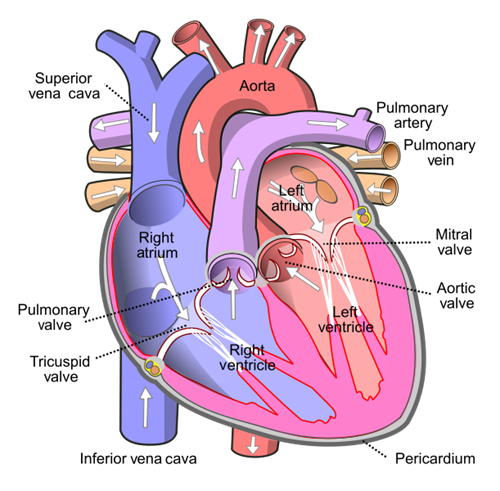
Human heart
The heart consists of three layers:
1. Pericardium - External layer
2. Myocardium - Middle layer
3. Endothelium - Internal layer
The blood transports both oxygen and carbon dioxide, and thus the heart has four different chambers that prevent the O_2-rich blood from mixing with the blood containing CO_2. The four chambers include the:
- Right atrium
- Right ventricle
- Left atrium
- Left ventricle
The left and the right atria are separated by an interatrial septum, while an interventricular septum separates the left and right ventricles.
What is a septum?
It is a wall, which is made up of cardiac muscles. The septum separates the heart chamber and prevents mixing of CO_2 blood to O_2 rich blood.
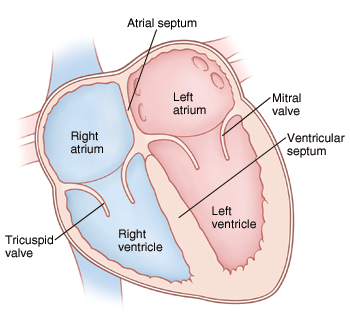
Interatrial and interventricular septum
Valves
There is the presence of four valves in the heart. They include:
- Mitral or bicuspid valve - present between left atrium and ventricle.
- Tricuspid valve - present between right atrium and ventricle.
- Pulmonary valve - present between the right ventricle and pulmonary artery.
- Aortic valve - present between the left ventricle and the aorta
Why are the valves present in the heart?
- Ensure a unidirectional flow of blood.
- Prevents the flow of blood backwards during the contraction of atria or ventricles.
Contraction of the heart is called systole, while the relaxation of the heart is called diastole. The CO_2-rich blood must reach the lungs to eliminate the CO_2, while the oxygenated blood is returned to the heart. The O_2-rich blood is subsequently circulated throughout the body.
The heart, thus, pumps blood in two separate circuits which run simultaneously.
- Pulmonary circulation - blood moves from the heart to the lungs and back to the heart.
- Systemic circulation - blood moves from the heart to the rest of the body and back to the heart. Systemic circulation carries oxygen to the tissues of the body and also removes CO_2 from the tissues.
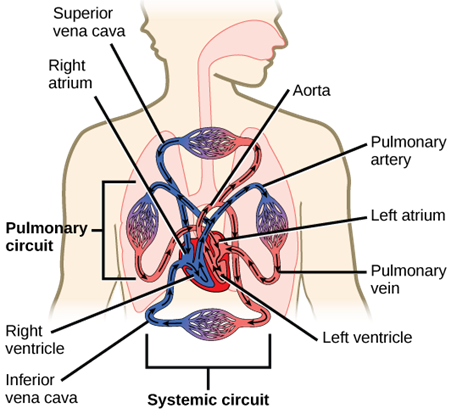
Transport and exchange of O_2 and CO_2
Circulation of blood in the heart
1. The right atrium receives deoxygenated blood from the different parts of the body through the superior and inferior vena cava. The right atrium relaxes during the process to collect the deoxygenated blood.
2. The right atrium contracts, and the right ventricle relaxes. Thus, the deoxygenated blood from the right atrium is sent to the right ventricle.
3. Next, the right ventricle contracts, and blood enters the pulmonary artery. Through the pulmonary artery, blood is pumped to the lungs for oxygenation. At the lungs, the exchange of gases takes place. The oxygen-rich blood is returned to the heart through the pulmonary veins.
4. The pulmonary veins carry the oxygenated blood to the left atrium from the lungs. The left atrium relaxes during the process to collect the oxygenated blood.
5. From the left atrium, the blood reaches the left ventricle due to the contraction of the left atrium. The left ventricle relaxes, and blood from the left atrium reaches the left ventricle. The oxygenated blood is forced into the ventricle through the atrioventricular openings by the atrial contraction.
6. Next, the left ventricle contracts and blood is pumped out to the various parts of the body through the aorta.
Aorta is the largest artery present in the body, taking oxygenated blood to various organs and muscles.
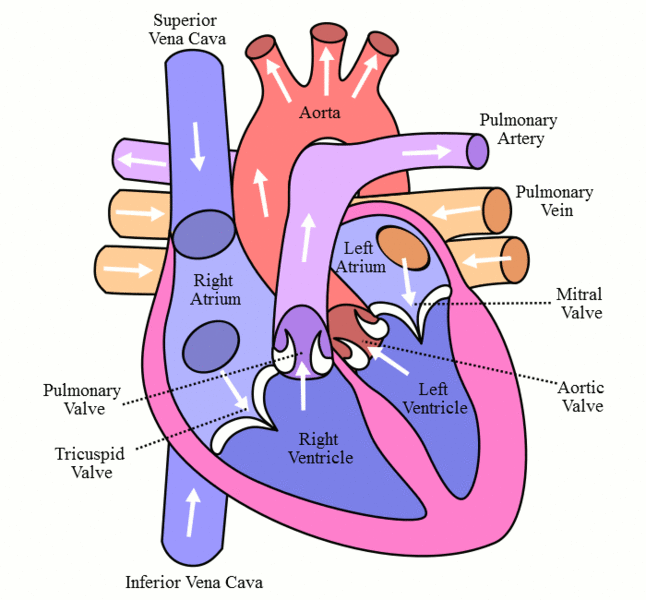
Circulation of blood in the heart
As you can see, the ventricles need to pump blood to the various organs, and thus they have thicker muscular walls than the atria.
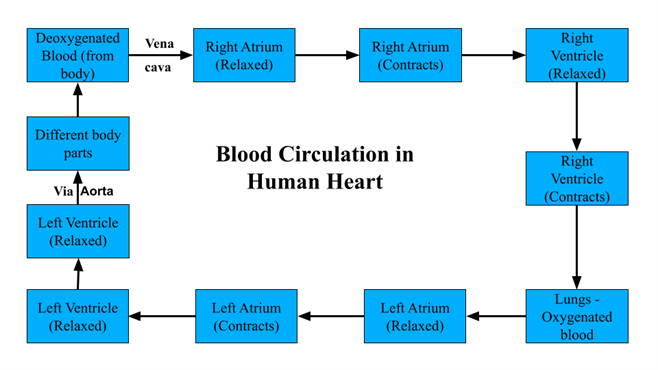
Reference:
https://commons.wikimedia.org/wiki/File:Diagram_of_the_human_heart_(cropped).svg
https://commons.wikimedia.org/wiki/File:Septum-SID.jpg
https://openstax.org/books/concepts-biology/pages/16-3-circulatory-and-respiratory-systems?query=exhalation&target=%7B%22type%22%3A%22search%22%2C%22index%22%3A0%7D#fs-idm56946064
https://commons.wikimedia.org/wiki/File:Blood_Circulation.gif
